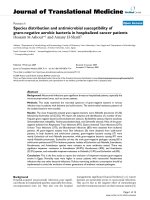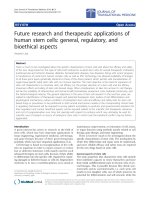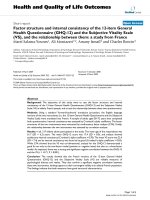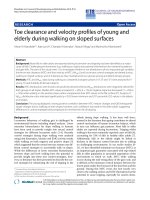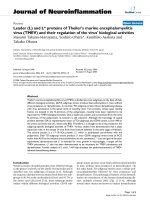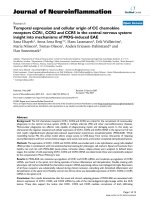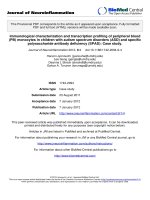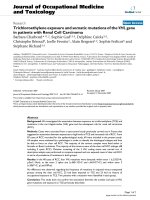báo cáo hóa học:" Structural, optical and magnetic studies of manganese-doped zinc oxide hierarchical microspheres by self-assembly of nanoparticles" docx
Bạn đang xem bản rút gọn của tài liệu. Xem và tải ngay bản đầy đủ của tài liệu tại đây (461.25 KB, 20 trang )
This Provisional PDF corresponds to the article as it appeared upon acceptance. Fully formatted
PDF and full text (HTML) versions will be made available soon.
Structural, optical and magnetic studies of manganese-doped zinc oxide
hierarchical microspheres by self-assembly of nanoparticles
Nanoscale Research Letters 2012, 7:100 doi:10.1186/1556-276X-7-100
Yao-Ming Hao ()
Shi-Yun Lou ()
Shao-Min Zhou ()
Rui-Jian Yuan ()
Gong-Yu Zhu ()
Ning Li ()
ISSN 1556-276X
Article type Nano Express
Submission date 11 November 2011
Acceptance date 2 February 2012
Publication date 2 February 2012
Article URL />This peer-reviewed article was published immediately upon acceptance. It can be downloaded,
printed and distributed freely for any purposes (see copyright notice below).
Articles in Nanoscale Research Letters are listed in PubMed and archived at PubMed Central.
For information about publishing your research in Nanoscale Research Letters go to
/>For information about other SpringerOpen publications go to
Nanoscale Research Letters
© 2012 Hao et al. ; licensee Springer.
This is an open access article distributed under the terms of the Creative Commons Attribution License ( />which permits unrestricted use, distribution, and reproduction in any medium, provided the original work is properly cited.
1
Structural, optical, and magnetic studies of manganese-doped zinc oxide
hierarchical microspheres by self-assembly of nanoparticles
Yao-Ming Hao
1
, Shi-Yun Lou
1
, Shao-Min Zhou*
1
, Rui-Jian Yuan
1
, Gong-Yu Zhu
1
, and
Ning Li
1
1
Key Lab for Special Functional Materials of Ministry of Education, Henan University,
Kaifeng, 475004, People's Republic of China
*Corresponding author:
Email addresses:
Y-MH:
S-YL:
S-MZ:
R-JY:
G-YZ:
NL:
Abstract
In this study, a series of manganese [Mn]-doped zinc oxide [ZnO] hierarchical
microspheres [HMSs] are prepared by hydrothermal method only using zinc acetate and
manganese acetate as precursors and ethylene glycol as solvent. X-ray diffraction
indicates that all of the as-obtained samples including the highest Mn (7 mol%) in the
crystal lattice of ZnO have a pure phase (hexagonal wurtzite structure). A broad Raman
spectrum from as-synthesized doping samples ranges from 500 to 600 cm
–1
, revealing the
successful doping of paramagnetic Mn
2+
ions in the host ZnO. Optical absorption
analysis of the samples exhibits a blueshift in the absorption band edge with increasing
dopant concentration, and corresponding photoluminescence spectra show that Mn
doping suppresses both near-band edge UV emission and defect-related blue emission. In
particular, magnetic measurements confirm robust room-temperature ferromagnetic
behavior with a high Curie temperature exceeding 400 K, signifying that the as-formed
Mn-doped ZnO HMSs will have immense potential in spintronic devices and spin-based
electronic technologies.
Keywords: Mn-doped ZnO; hierarchical microspheres; optical properties; magnetic
properties.
Introduction
Zinc oxide [ZnO] exhibits many fascinating properties [1-7]. It is an intrinsic n-type II-VI
semiconductor with a wide bandgap of 3.37 eV at room temperature [RT] and a large
excitation binding energy of 60 meV. Because of these properties, ZnO presents a strong
excitonic UV light emission at RT [2-6]. It also presents a high photoconductivity and
2
considerable piezoelectric and pyroelectric properties [1]. Because of these properties,
ZnO has attracted much attention for potential applications in various electronic and
optoelectronic devices. In particular, the interest in ZnO has significantly been increased
in the last decade [7-21] since the theoretical prediction of above RT ferromagnetism
[RTFM] in Mn-doped ZnO diluted magnetic semiconductors [DMSs] by Dietl et al. [8].
DMSs are materials that simultaneously exhibit ferromagnetic and semiconducting
properties. In DMS materials, magnetic transition ions substitute a small percentage of
cation sites of the host semiconductor and are coupled with free carriers to yield
ferromagnetism via indirect interaction [9-12]. DMSs are considered to be very important
materials in future semiconductor spintronic applications due to the simultaneous control
of ‘electron’ charge and spin [9-12]. Among all the magnetic transition ion-doped ZnO
systems, Mn doping is usually the single most concerned mainly because of the fact that
the thermal solubility of metallic Mn is larger than 10 mol% in ZnO, and the ‘electron
effective mass’ is as large as approximately 0.3 me, where ‘me’ is the free-electron mass
[13]. Therefore, injected spins and carriers in the nanostructures can be large, thus
making Mn-doped ZnO ideal for the fabrication of spintronic nanodevices. For practical
applications, a high-performance DMS with a high Curie temperature [T
C
] and saturation
magnetic moments [M
S
] is required. However, until now, the mechanism involved in
ferromagnetism [FM] is complicated and the reproducibility of ferromagnetic behavior is
still a challenging problem. Because several groups have obtained different properties
such as paramagnetism, anti-FM, and FM in Mn-doped ZnO [12, 13, 19-21], these
magnetic properties are strongly dependent on the sample preparation conditions.
Therefore, the development of a more controllable and repeatable synthetic route for
RTFM Mn-doped ZnO nano/microstructures is crucial to their practical applications.
The fabrication of hierarchical and self-assembly (self-aggregation)
micro-/nanostructures using nanoparticles, nanorods, nanoplatelets, etc. as building
blocks at different levels have become a hot topic in recent material research fields
[14-16]. Self-assembly and/or self-aggregation are fundamental mechanisms by which
different nanoparticle assembly motifs or even close-packed periodic structures form in
materials through spatial arrangement of their fundamental building blocks. The forces
that controlled the assembly are determined by competing noncovalent intramolecular or
intraparticulate interactions. The hierarchical structures obtained through the assembly of
nanocrystalline building blocks provide new opportunities for optimizing, tuning, and/or
enhancing the properties and performance of the materials [14-16]. So far, considerable
efforts have been devoted to synthesize Mn-doped ZnO systems with RTFM including
nanoparticles, nanowires, and thin films using different methods such as pulsed laser
deposition, magnetron co-sputtering, and chemical vapor deposition [17-19]. However,
there are very few reports on the synthesis of hierarchical spherical superstructures of
Mn-doped ZnO DMS materials in solution phase. Herein, we only use zinc acetate and
manganese acetate as precursors and ethylene glycol [EG] as solvent to synthesize
Mn-doped ZnO hierarchical microspheres [HMSs] by self-assembly of nanoparticles. In
particular, magnetic measurements confirm robust RTFM behavior with a high T
C
over
400 K. To our knowledge, there is no report on the Mn-doped ZnO hierarchical spherical
structures showing a robust RTFM behavior with a high T
C
.
3
Meanwhile, optical properties of Mn-doped ZnO are currently the subject of numerous
investigations in response to a strong demand for nano-/microscale magneto-optic
devices in the future. However, it is unfortunate that although most of the Zn/Mn bulk
and nanostructure materials exhibit RTFM, strong UV photoluminescence [PL] is hardly
achieved. This may be due to the difficulty in controlling the interaction between the Mn
dopant and intrinsic defects such as oxygen vacancies during the fabrication process
[22-26]. So far, its luminescence mechanism has still been in discussion [22-26]. With the
aim of providing further understanding of the optical nature of Mn-doped ZnO HMSs,
UV-visible [vis] and PL spectra are used to study their optical characteristics, and the
corresponding mechanism has been discussed. Also, the surface morphology of the
products was investigated by scanning/transmission electron microscopy [SEM/TEM] or
by high-resolution TEM [HRTEM]. The structure was studied by X-ray diffraction [XRD]
and using Raman and Fourier transform infrared spectroscopy [FTIR] spectra.
Experimental section
Zinc acetate [Zn(CH
3
COO)
2
·2H
2
O], manganese acetate [Mn(CH
3
COO)
2
·2H
2
O], and EG
are analytic grade reagents and purchased without further treatment. In a typical process,
4 mmol of mixed reactants of [Zn(CH
3
COO)
2
·2H
2
O] with different amounts of
[Mn(CH
3
COO)
2
·2H
2
O] was dissolved in 30 mL of EG. The mixture was stirred
vigorously for 1 h, sealed in a Teflon-lined stainless steel autoclave of 50-mL capacity
kept at 180°C for 5 h, and then allowed to cool to RT naturally. Yellow Mn-doped ZnO
precipitates were centrifugally collected and rinsed with absolute ethanol several times.
Finally, the precipitates were dried in air at 60°C overnight.
The morphologies and microstructures of these as-fabricated specimens were investigated
by SEM/TEM (JSM5600LV, JEOL 2010, JEOL Ltd., Akishima, Tokyo, Japan), selected
area electron diffraction [SAED], and HRTEM (JEOL Ltd, Akishima, Tokyo, Japan). The
sample phases, crystal structures, chemical compositions, and element valences of the
Mn-doped ZnO samples were detected by XRD (Phillips X'Pert Pro MPD, PANalytical
B.V., Almelo, The Netherlands), Raman spectroscopy (microscopic confocal Raman
spectrometer, RW-1000, Renishaw, Wotton-under-Edge, UK), and X-ray photoelectric
spectrum [XPS] (KRATOS AXIS ULTR, Kratos Analytical, Ltd., Manchester, UK),
respectively. RTPL measurement was carried with a fluorescence spectrophotometer
(SPEX F212, Spex Industries, Metuchen, NJ, USA) with an Xe lamp as the excitation
light source (330 nm). UV-vis absorption was carried with a UV-vis absorption
spectrometer (Lambda35, PerkinElmer, Boston, MA, USA). The molecular structure of
the as-synthesized samples was studied using FTIR spectra (Shimadzu-8700, Shimadzu
Corporation, Nakagyo-ku, Kyoto, Japan). Magnetic properties were carried out using
Quantum Design's superconductor quantum interference device [SQUID] (MPMS XL7,
San Diego, CA, USA).
Results and discussion
The macrographs of Zn
1−x
Mn
x
O HMSs (x = 0, 0.02, 0.05, and 0.07) are demonstrated in
Figure 1a. We can find that the pure ZnO samples present a white color, while Mn-doped
4
ZnO HMSs for different concentrations become light yellow, and the color becomes
deeper and deeper with increasing Mn. The phase purity and crystal structure of the
pristine ZnO and Mn-doped ZnO for various doping levels have been analyzed by XRD.
All of the diffraction peaks can be indexed to the wurtzite structure of ZnO (space group
P63mc; Figure 1b). The data are in agreement with the Joint Committee on Powder
Diffraction Standards' card for ZnO (36-1451). There is no indication of any secondary
phase or clusters, confirming that the samples are only one single phase. The XRD results
also indicate that the Mn
2+
ions systematically substituted for the Zn
2+
ions in the sample
without changing the wurtzite structure, as shown in the inset of Figure 1b. The most
intense diffraction peak (101) is clearly evident with a slight shift into low angular scale,
whereas the corresponding intensity decreases compared with undoped ZnO. Furthermore,
the intensity of the diffraction peaks decreases, and the width broadens due to the
formation of smaller grain diameters as a result of an increase in disorder on Mn
2+
doping.
Also, the evolution of unit cell parameters as a function of Mn content has been given in
Table 1. The overall trend shows that the lattice parameters are increasing with an
increase of Mn content. This is consistent with the fact that the ionic radius of Mn
2+
is
0.80 Å, whereas that of Zn
2+
is 0.74 Å. The shifting and broadening of XRD lines with
doping strongly suggest that Mn
2+
successfully substituted into the ZnO host structure at
the Zn
2+
site.
The composition, quality, and molecular structure of the product were analyzed by FTIR
spectroscopy. FTIR measurements of all the samples were performed in the wave number
range from 400 to 4,000 cm
−1
using the KBr method at RT as shown in Figure 1c. The
broad absorption peak around 3,500 cm
−1
represents the stretching vibration of the O-H
group. The absorption peaks observed between 2,300 and 2,400 cm
−1
are assigned to the
CO
2
mode [27]. The CO
2
modes are present in the FTIR spectra not owing to the serious
contamination in Mn-doped ZnO HMSs, but these modes may be due to atmospheric CO
2
in the samples. Samples might have trapped some CO
2
from the atmosphere during FTIR
characterization which might have given such modes [27]. Two principal absorption
peaks at 1,580 and 1,400 cm
−1
with a wave number separation of 180 cm
−1
correspond to
the asymmetric stretching υ
as
(COO
−
) and symmetric stretching υ
s
(COO
−
) vibrations of
unidentate acetate species [28]. These characteristic bands of 3,126, 1,090, and 1,050
cm
−1
are attributed to a neutrally adsorbed EG on the surface without an obvious shift in
wave numbers compared with pure EG. The band at 1,330 cm
−1
is assigned to the
stretching vibrations of δ (CH
3
) [28]. The bending vibration of the interlayer water
molecule appeared with the typical band at 1,635 cm
−1
. The absorption band at 431 cm
−1
is assigned to the stretching mode of ZnO [29]. However, in the case of the Zn
1−x
Mn
x
O
HMSs (x =0.02, 0.05, and 0.07), the values of absorption bands are found to be
blueshifted at 438, 445, and 456 cm
−1
, respectively. The enlarged spectrum in the wave
number range is shown in the inset of Figure 1c. The change in the peak position of the
ZnO absorption bands reflects that the Zn-O-Zn network is perturbed by the presence of
Mn in its environment.
The morphology and further structural characterization of as-obtained Mn-doped ZnO
HMSs have been carried out using SEM/TEM. Large-scaled and monodispersed
Zn
0.93
Mn
0.07
O HMSs observed in Figure 2a have been successfully prepared. The TEM
5
images (Figure 2b) for a representative sample depict that the mean diameter of the
Zn
0.93
Mn
0.07
O HMSs is about 1 to 1.5 µm. The high magnifying TEM micrograph (Figure
2c) clearly shows that the samples are composed of closely packed small nanoparticles.
The lattice spacing ((002) for 0.27 nm) of Zn
0.93
Mn
0.07
O HMSs observed throughout the
HRTEM image (Figure 2d) is a little larger than that ((002) for 0.26 nm) of the undoped
ZnO HMSs (not shown), which is due to the bigger ionic radius of Mn (0.80 Å) than that
of Zn (0.74 Å) and due to more structural defects. The absence of any impurity phase
such as Mn and Mn-based secondary phases in the nanosize range has been further
confirmed by SAED studies (inset of Figure 2d).
The XPS spectra were used to investigate the composition and chemical bond
configuration of the Zn
0.93
Mn
0.07
O HMSs. The binding energies are calibrated by the
carbon C
1s
peak (284.6 eV). The elements of Zn, Mn, O, and adventitious C can be
detected as shown in Figure 3a. The high-resolution XPS spectra of Zn and Mn species
are further illustrated in Figure 3b,c, respectively. In Figure 3b, two strong peaks that
appeared at 1,044.2 and 1,021.1 eV can be attributed to Zn2p
3/2
and Zn2p
1/2
, respectively.
The narrow line widths (2 eV) of these peaks indicate that Zn
2+
ions are dominant in the
samples as highlighted in Figure 3b. The Mn2p
3/2
of Zn
0.93
Mn
0.07
O HMSs is observed at
640.8 eV, indicating the existence of Mn
2+
ions in microspheres (the metallic Mn and
Mn
4+
ion should be at 637.7 and 642.4 eV, respectively) [30].The results previously
discussed are consistent with other reports as well [31]. The XPS data of Zn2p and Mn2p
further provide evidences for the incorporation of Mn
2+
ions into ZnO.
To obtain a better understanding of the formation of Mn-doped ZnO HMSs, a probable
growth mechanism can be proposed. As far as we know, as a wurtzite structure, ZnO
belongs to the P63mc space group, and it can be described as a number of alternating
planes composed of tetrahedrally coordinated O
2−
and Zn
2+
ions, staked alternately along
the c-axis. The positively Zn
2+
-terminated (001) polar surfaces of ZnO have the
maximum surface energy, while the negatively O
2−
-terminated (00-1) polar surfaces have
the minimum surface energy. As a result, the crystal of ZnO nanostructures grows
preferentially along the (001) direction, while the growth velocity along other directions
is relatively low. Thus, one-dimensional [1-D] structure of ZnO is easily formed.
However, why does Mn-doped ZnO in our experiments form globular structures instead
of a 1-D structure? We think that EG has a great influence on the morphology of the
fabricated Mn-doped ZnO. EG is a polar solvent with a high boiling point (approximately
198°C) and a high permittivity of 37 at 20°C, which is believed to have a high dissolving
capacity for polar inorganic materials. Moreover, it is also a strong reducing agent. Here,
we propose a two-step self-assembly process for the synthetic Mn-doped ZnO HMSs. As
shown in Figure 4, the first route depicts the formation process of Mn-doped ZnO
nanoparticles due to the reducing capacity of EG. According to the report, acetaldehyde
(CH
3
CHO) is produced by dehydration of EG at a high temperature, where CH
3
CHO can
donate a hydrogen atom (H) and can act as a reducing agent as shown in Equation 1 [32].
Consequently, Mn-doped ZnO nanoparticles could nucleate through the reduction of
Zn(Ac)
2
/Mn(Ac)
2
with the newly produced hydrogen atom which is expressed in
Equation 2. The second route is the coordination route of EG which directs the formation
of Mn-doped ZnO HMSs in view of morphology transformation. A lot of EG molecules
6
are adsorbed on the (001) surface of the ZnO crystals and block the crystal growth along
both sides of the c-axis. Apart from this, acetic acid could react with EG by esterification
(Equation 3), which enlarges the surface modification effect of these small molecules on
the surface state [33]. The fresh Mn-doped ZnO crystalline nanoparticles with a large
exposed surface are unstable and tend to aggregate to form metastable spheres, driven by
the minimum surface tension and the lowest energy for the spherical structure, and finally
lead to the formation of globular structures:
2 2 3 3 3
2HOCH CH OH 2CH CHO CH COOCH 2H
→ → + , (1)
(
)
(
)
1 3
2 2
Zn Ac / Mn Ac 2H Zn Mn O CH COOH
x x−
+ → + , (2)
and
(
)
(
)
2 3 3 2 3 2
2 2
HO CH OH 2CH COOH CH COOCH CH 2H O
+ → +
. (3)
Based on the mentioned analysis, EG plays at least a triple role. Firstly, it acts as a
solvent, providing a medium for the reagents. Secondly, it serves as the reductant which
reduces Zn(Ac)
2
/Mn(Ac)
2
to Mn-doped ZnO crystalline nanoparticles. Finally, it
coordinates Mn-doped ZnO nanocrystals to direct the formation of Mn-doped ZnO
HMSs.
Raman spectroscopy is a fast and powerful technique for studying dopant incorporation,
induced defects, and disorder in the ZnO host lattice. Raman spectroscopy has also been
used to examine crystal quality for various ZnO nanostructures or to find possible
secondary oxide phase in magnetic transition ion-doped ZnO. Wurtzite hexagonal-shaped
ZnO belongs to the P63mc symmetry group, with two formula units per primitive cell,
where all of the atoms are occupying the C
3V
sites. According to the group theory, single
crystalline ZnO has eight sets of optical phonon modes at Γ point of the Brillouin zone,
classified as
1 1 2
A E 2E
+ + modes (Raman active),
1
2B
modes (Raman silent), and
1 1
A E
+ modes (infrared active). Moreover, the
1 1
A E
+ modes are polar and split into
the transverse optical and longitudinal optical [LO] phonons. E
2
modes with two modes
of low and high frequencies are Raman active only, while the B
1
modes are silent. Figure
5a shows the Raman spectra of the Zn
1−x
Mn
x
O HMSs (x = 0, 0.02, 0.05, and 0.07). The
sharpest and strongest peak at about 437 cm
−1
can be assigned to the high frequency
branch of the E
2
mode of ZnO, which is the main Raman mode in the wurtzite crystal
structure. It is related to the motion of oxygen atoms and sensitive to internal stress [34,
35]. While the peak at about 580 cm
−1
can be assigned to A
1
(LO) mode, it is sensitive to
changes in the free carrier concentration [36]. Origin of the above mode may be caused
by the Zn interstitial. The 331 cm
−1
frequency is the second-order vibration mode arising
from the E
2
(high)-E
2
(low) multiple scattering process. For all samples, the decreased
intensity of the peak at about 437 cm
−1
with Mn doping further indicates that the
crystallization of the HMSs becomes worse. In addition, the peaks of E
2
(high) and A
1
(LO)
mode that shift to lower frequencies with the increase of Mn content indicate that the
tensile stress has become increasingly large in the crystal. The tensile stress may come
from the increase of defects such as vacancies and interstitials that arose from Mn
2+
substituted for Zn
2+
in the ZnO matrix. Notably, in comparison with the Raman spectra
from undoped ZnO, the anomalous broad band starts to appear from the 500- to 600-cm
−1
7
region, which is named as an indicator of the Mn incorporation into the ZnO matrix [37,
38]. A recent report has shown that the anomalous modes in the 500-to 600-cm
−1
region
have a symmetry, and the Raman scattering forming these modes has a resonance with
the Mn
2+
-related optical absorption. The authors have justified the Raman spectral
distribution in this region as the Fermi resonance interaction between the overtone 2B
and one-phonon A
1
(LO) modes [37].
Figure 5b shows the UV-vis absorption spectra of ZnO with different Mn concentrations.
The absorption edges of Zn
1−x
Mn
x
O (x = 0, 0.02, 0.05, and 0.07) are 370, 363, 358, and
355 nm, respectively. The position of the absorption spectra is observed to shift towards
the lower wavelength side with increasing Mn-doped concentration in ZnO. This
indicates that the bandgap of the ZnO material increases with the doping concentration of
the Mn
2+
ion. The increase in the bandgap or blueshift can be explained by the
Burstein-Moss effect [39]. This is the phenomenon that the Fermi level merges into the
conduction band with increasing of the carrier concentration. Thus, the low energy
transitions are blocked. The results are in good agreement with the results reported by
Sakai and Rekha [40, 41].
The optical emission properties of the Zn
1−x
Mn
x
O HMSs (x = 0, 0.02, 0.05, and 0.07)
were investigated by PL spectroscopy (Figure 5c) using a 330-nm excitation wavelength
of Xe laser at RT. Typically, the following two bands have appeared in the PL spectra: the
near-band edge emission in the UV region, which originates due to the recombination of
free excitons through an exciton-exciton collision process, and the deep level emission in
the visible region, caused by impurities and structural defects of the crystal. Herein, we
found that our samples exhibit a UV emission peak at 395 nm and three defect peaks
corresponding to blue emissions near 425 and 475 nm and to green emission near 490 nm
in the PL spectra. The origin of the peaks at 425 and 475 nm could be ascribed due to the
transition occurring from Zn interstitials to the valence band, and the peak of 425 nm may
be the result of the singly ionized oxygen vacancy [42]. The increase of the Mn
concentration leads to the intensity reduction of both UV and blue emissions, which is
mainly due to the increase of defect concentration induced by Mn doping. Besides, the
worse crystallization caused by Mn doping is another reason for the rapid decrease in UV
emission intensity [43]. This is in agreement with the Raman spectra.
The magnetization versus temperature properties were characterized using Quantum
Design's SQUID magnetometer equipped with a 7-T magnet in the temperature range of
4 to 400 K. Figure 6a shows the magnetization of Zn
0.93
Mn
0.07
O HMSs as a function of
temperature obtained at the zero-field-cooled [ZFC] and field-cooled [FC] processes with
an applied magnetic field of 1,000 Oe. It is evident that the Zn
0.93
Mn
0.07
O HMSs are
ferromagnetic with T
C
higher than 400 K due to the clear separation between the FC and
ZFC processes. The ZFC-FC magnetization curves clearly indicate that the sample is
quite thermally stable without blocking (or superparamagnetic behavior), which is similar
to an earlier report on Mn-doped nanoparticles [44]. In addition, magnetic hysteretic
loops for the samples with three levels of Mn doping from SQUID measurements are
shown in Figure 6b. The magnetization versus magnetic field [M-H] loops for the
Zn
1−x
Mn
x
O HMSs (x = 0.02, 0.05, and 0.07) at RT exhibit the coercive field of
8
approximately 280, 255, and 203 Oe, respectively. The coercivity decreases with
increasing manganese doping level. The saturation magnetization [Ms] values of the three
samples were found to increase with increasing manganese doping. Nevertheless, Ms per
manganese still decreases with increasing content of Mn. The value of Ms is 0.0209
µ
B
/Mn for 2% Mn doping and 0.0144 µ
B
/Mn for 5% Mn doping, and it decreases to
0.0111 µ
B
/Mn for 7% Mn doping. Similar phenomena have been observed in other DMS
materials [45, 46]. Unlike our previous work [47], here, indirect interaction among Mn
2+
centers leads to FM, whereas direct interaction among them leads to anti-FM. With
increase in Mn doping, the average distance between Mn
2+
ions decreases, resulting in
the enhancement of the antiferromagnetic contribution [46].
Furthermore, it should be
pointed out that these values are much smaller than the theoretical value of 5 µ
B
/Mn for a
free Mn
2+
ion [47, 48]. This can be attributed to the antiferromagnetic superexchange
interactions between adjacent Mn
2+
ions [48]. We can therefore attribute the RTFM of the
Mn-doped ZnO HMSs to the magnetic coupling between Mn atoms [48].
Conclusion
To summarize, Zn
1−x
Mn
x
O HMSs (x = 0, 0.02, 0.05, and 0.07) with the hexagonal
wurtzite structure are synthesized by a simple hydrothermal method. The results of XRD,
XPS, and Raman spectrum confirm that Mn
2+
ions are successfully incorporated into the
ZnO host lattice at the Zn
2+
site. The doping of Mn ions suppressed both near-band edge
UV emission and defect-related blue emission, which could be mainly caused by the
lattice defect increase due to Mn doping into ZnO lattice. In particular, the magnetic
measurements reveal that the as-formed Mn-doped ZnO HMSs have above RTFM.
Competing interests
The authors declare that they have no competing interests.
Authors' contributions
Y-MH did the synthesis, performed tests on the samples, and wrote the manuscript.
S-MZ carried out the magnetic characterization. S-MZ, S-YL, G-YZ, R-JY, and NL
modified the manuscript. S-MZ gave the final approval of the version to be published.
All the authors read and approved the final manuscript.
Acknowledgments
This work was partially supported by the program for Science and Technology
Innovation Talents in Universities of Henan Province (no. 2008 HASTIT002) and by
the Natural Science Foundation of China under grant no. 20971036.
References
1. Wang Z, Song J: Piezoelectric nanogenerators based on zinc oxide nanowire
9
arrays. Science 2006, 312:242-246.
2. Tang Z, Wong G, Yu P, Kawasaki M, Ohtomo A, Koinuma H, Segawa Y:
Room-temperature ultraviolet laser emission from self-assembled ZnO
microcrystallite thin films. Appl Phys Lett 1998, 72:3270-3272.
3. Bilecka I, Elser P, Niederberger M: Kinetic and thermodynamic aspects in the
microwave-assisted synthesis of ZnO nanoparticles in benzyl alcohol. ACS nano
2009, 3:467-477.
4. Qurashi A, Tabet N, Faiz M, Yamzaki T: Ultra-fast microwave synthesis of ZnO
nanowires and their dynamic response toward hydrogen gas. Nanoscale Res
Lett 2009, 4:948-954.
5. Chen H, Wu X, Gong L, Ye C, Qu F, Shen G: Hydrothermally grown ZnO
micro/nanotube arrays and their properties. Nanoscale Res Lett 2010,
5:570-575.
6. Dhara1 S, Giri P: Enhanced UV photosensitivity from rapid thermal annealed
vertically aligned ZnO nanowires. Nanoscale Res Lett 2011, 6:504.
7. Balti I, Mezni A, Dakhlaoui-Omrani A, Leone P, Viana B, Brinza O, Smiri L, Jouini
N: Comparative study of Ni- and Co-substituted ZnO nanoparticles: synthesis,
optical, and magnetic properties. J Phys Chem C 2011, 115:15758-15766.
8. Dietl T, Ohno H, Matsukura F, Cibert J, Ferrand D: Zener model description of
ferromagnetism in zinc-blende magnetic semiconductors. Science 2000,
287:1019-1022.
9. Zhou S, Liu L, Yuan H, Chen X, Lou S, Hao Y, Yuan R, Li N: Magnetic properties
of Ni-doped ZnO nanocombs by CVD approach. Nanoscale Res Lett 2010,
5:1284-1288.
10. Shi H, Duan Y: First-principles study of magnetic properties of 3d transition
metals doped in ZnO nanowires. Nanoscale Res Lett 2009, 4:480-484.
11. Zhou S, Yuan H, Liu L, Chen X, Lou S, Hao Y, Yuan R, Li N:
Room-temperature ferromagnetism of diamagnetically-doped ZnO aligned
nanorods fabricated by vapor reaction. Appl Phys A 2011, 102:367-371.
12. Yang H, Yu S, Lau S, Herng T, Tanemura M: Ultraviolet laser action in
ferromagnetic Zn
1−x
Fe
x
O nanoneedles. Nanoscale Res Lett 2010, 5:247-251.
13. Fukumura T, Jin Z, Ohtomo A, Koinuma H, Kawasaki M: An oxide-diluted
magnetic semiconductor:Mn-doped ZnO. Appl Phys Lett 1999, 75:3366-3368.
14. Zeng X, Yuan J, Zhang L: Synthesis and photoluminescent properties of rare
10
earth doped ZnO hierarchical microspheres. J Phys Chem C 2008,
112:3503-3508.
15. Barick K, Aslam M, Dravid V, Bahadur D: Self-aggregation and assembly of
size-tunable transition metal doped ZnO nanocrystals. J Phys Chem C 2008,
112:15163-15170.
16. Liu Z, Zhang Q, Shi G, Li Y, Wang H: Solvothermal synthesis and
magneto-optical properties of Zn-Ni-O hierarchical microspheres. J Magn
Magn Mater 2011, 323:1022-1026.
17. Duan L ,Zhao X, Liu J, Geng W, Xie H, Chen S: Structural, thermal and
magnetic investigations of heavily Mn-doped ZnO nanoparticles. J Magn
Magn Mater 2011, 323:2374-2379.
18. Mi W, Bai H, Liu H, Sun C: Microstructure, magnetic, and optical properties
of sputtered Mn-doped ZnO films with high-temperature ferromagnetism. J
Appl Phys 2007, 101:023904-023908.
19. Liu J, Wang K, Yu M, Zhou W: Room-temperature ferromagnetism of Mn
doped ZnO aligned nanowire arrays with temperature dependent growth. J
Appl Phys 2007, 102:024301-024306.
20. Cheng X, Chien C: Magnetic properties of epitaxial Mn-doped ZnO thin films.
J Appl Phys 2003, 93:7876-7878.
21. Yoon S, Cho S, We S, Yoon S, Suh B, Song H, Shin Y: Magnetic properties of
ZnO-based diluted magnetic semiconductors. J Appl Phys 2003,
93:7879-7881.
22. Philipose U, Nair S, Trudel S, Souza C, Aouba S, Hill R, Ruda H:
High-temperature ferromagnetism in Mn-doped ZnO nanowires. Appl Phys
Lett 2006 88:263101-263103.
23. Liang H, Yu S, Lau S, Herng T, Tsang S, Wang L, Chen J, Teng K: Optical and
ferromagnetic characteristics of Mn doped ZnO thin films grown by filtered
cathodic vacuum arc technique. Thin Solid Films 2010, 518:7048-7052.
24. VidyaSagar R, Buddhudu S: Structural and photoluminescence analysis of
Zn
1−x
Mn
x
O nanocrystalline powders. Phys Lett A 2009, 373:3184-3189.
25. Jiang F, Zhang J: Temperature-dependent shifts of ultraviolet multipeak
emissions for Mn-doped ZnO nanowires. Appl Phys Lett 2011,
98:181912-181914.
26. Park J, Lee K, Kweon H, Lee C: Evidence of hydrogen-mediated ferromagnetic
11
coupling in Mn-doped ZnO. Appl Phys Lett 2011, 98:102502-102504.
27. Dole B, Mote V, Huse V, Purushotham Y, Lande M, Jadhav K, Shah S: Structural
studies of Mn doped ZnO nanoparticles. Curr Appl Phys 2011, 11:762-766.
28. Xie X, Shang P, Liu Z, Lv Y, Li Y, Shen W: Synthesis of nanorod-shaped cobalt
hydroxycarbonate and oxide with the mediation of ethylene glycol. J Phys
Chem C 2010, 114:2116-2123.
29. Silva R, Zaniquelli M: Morphology of nanometric size particulate
aluminium-doped zinc oxide films. Colloid Surf A 2002, 198:551-558.
30. Cong C, Liao L, Li J, Fan L Zhang K: Synthesis, structure and ferromagnetic
properties of Mn-doped ZnO nanoparticles. Nanotechnology 2005,
16:981-984.
31. Xu H, Liu Y, Xu C, Liu Y, Shao C, Mu R: Room-temperature ferromagnetism
in (Mn, N)-codoped ZnO thin films prepared by reactive magnetron
cosputtering. Appl Phys Lett 2006, 88:242502-242504.
32. Wan S, Guo F, Shi L, Peng Y, Liu X, Zhang Y, Qian Y: Single-step synthesis of
copper sulfide hollow spheres by a template interface reaction route. J Mater
Chem 2004, 14:2489-2491.
33. Liang X, Xiao J, Chen B, L Y: Catalytically stable and active CeO
2
mesoporous
spheres. Inorg Chem 2010, 49:8188-8190.
34. Cao B, Cai W, Zeng H, Duan G: Morphology evolution and photoluminescence
properties of ZnO films electrochemically deposited on conductive glass
substrates. J App Phys 2006, 99:073516-073521.
35. Duan L, Rao G, Wang Y, Yu J, Wang T: Magnetization and Raman scattering
studies of (Co, Mn) codoped ZnO nanoparticles. J Appl Phys 2008,
104:013909-013913.
36. Huang Y, Liu M, Li Z, Zeng Y, Liu S: Raman spectroscopy study of ZnO-based
ceramic films fabricated by novel sol–gel process. Mater Sci Eng B 2003,
97:111-116.
37. Mavrin B, Demyanets L, Zakalukin R: Raman spectroscopy and Fermi
resonance in Mn-doped ZnO bulk single crystal. Phys Lett A 2010,
374:4054-4056.
38. Qing-Bo H, Jia-Yue X, Li X, Kamzin A, Kamzina L: Raman spectroscopy and
magnetic properties of Mn-doped ZnO bulk single crystal. Chin Phys Lett
2007, 24:3499-3501.
12
39. Suwanboon S, Ratana T, Ratana W: Fabrication and properties of
nanocrystalline zinc oxide thin film prepared by sol-gel method. J Sci Technol
2008, 30:65-69.
40. Sakai K, Kakeno T, Ikari T, Shirakata S, Sakemi T, Awai K, Yamamoto T: Defect
centers and optical absorption edge of degenerated semiconductor ZnO thin
films. J Appl Phys 2006, 99:043508-043514.
41. Rekha K, Nirmala M, Nair M, Anukaliani A: Structural, optical, photocatalytic
and antibacterial activity of zinc oxide and manganese doped zinc oxide
nanoparticles. Physica B 2010, 405:3180-3185.
42. Fang Z, Wang Y, Xu D, Tan Y, Liu X: Blue luminescent center in ZnO films
deposited on silicon substrates. Opt Mater 2004, 26:239-242.
43. Lang J, Han Q, Li C, Yang J, Li X, Yang L, Wang D, Zhai H, Gao M, Zhang Y,
Liu X, Wei M: Effect of Mn doping on the microstructures and
photoluminescence properties of CBD derived ZnO nanorods. Appl Surf Sci
2010, 256:3365-3368.
44. Jayakumar O, Sudakar C, Vinu A, Asthana A, Tyagi A: Effect of surfactant
treatment on the magnetic properties of Mn-doped ZnO bulk and
nanoparticles. J Phys Chem C 2009, 113:4814-4819.
45. Venkatesan M, Fitzgerald C, Lunney J, Coey J: Anisotropic ferromagnetism in
substituted zinc oxide. Phys Rev Lett 2004, 93:177206.
46. Qiu Y, Chen W, Yang S, Zhang B, Zhang X, Zhong Y, Wong K: Hierarchical
hollow spheres of ZnO and Zn
1−-x
Co
x
O: directed assembly and
room-temperature ferromagnetism. Cryst Growth Des 2010, 10:177-183.
47. Hao Y, Lou S, Zhou S, Wang Y, Chen X, Zhu G, Rui J, Li N: Novel magnetic
behavior of Mn-doped ZnO hierarchical hollow spheres. J Nanopart Res 2012
14:659.
48. Lin X, Zhu Y, Shen W: Synthesis and optical and magnetic properties of
diluted magnetic semiconductor Zn
1-x
Mn
x
O hollow spherical structures. J
Phys Chem C 2009, 113:1812-1817.
Figure 1. Macrographs (a), XRD (b), and FTIR (c) spectra patterns.
Figure 2. SEM, TEM (a, b), HRTEM (c), and SAED (inset) (d) for Zn
0.93
Mn
0.07
O
HMSs.
13
Figure 3. XPS for Zn
0.93
Mn
0.07
O HMSs. The elements of Zn, Mn, O, and adventitious C
(a). The high-resolution XPS spectra of Zn (b) and Mn (c) species.
Figure 4. Illustration of the formation process.
Figure 5. Raman scattering (a) and UV-vis absorption (b) spectra, and PL
spectroscopy (c).
Figure 6. Magnetization. The magnetization as a function of temperature for (a) FC and
ZFC (Zn
0.93
Mn
0.07
O HMSs); RT M-H (b) of Zn
1−x
Mn
x
O HMSs (x = 0.02, 0.05,
and 0.07).
Table 1. The unit cell parameters
Material a (nm) c (nm)
Pure ZnO 0.32425 0.52007
Zn
0.98
Mn
0.02
O 0.32663 0.52536
Zn
0.95
Mn
0.05
O 0.32914 0.53292
Zn
0.93
Mn
0.07
O 0.33208 0.53819
Figure 1
Figure 2
Figure 3
Figure 4
Figure 5
Figure 6
